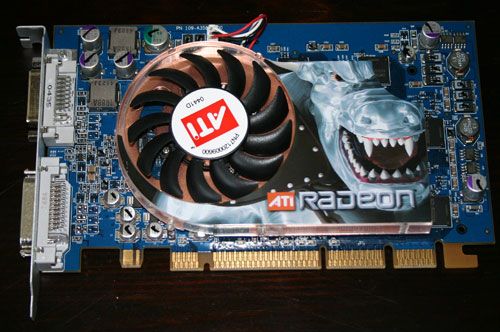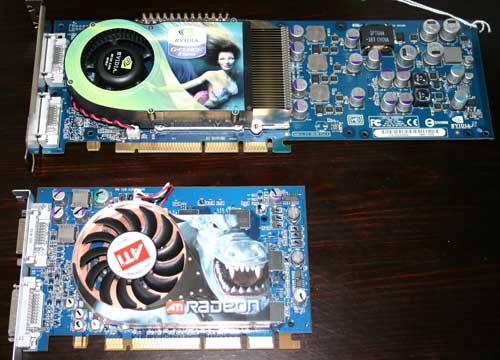ATI Radeon X800 XT Mac Edition: Competition in the Mac Market
by Anand Lal Shimpi on January 5, 2005 7:38 PM EST- Posted in
- Mac
In the PC world, ATI and NVIDIA duke it out every 6 months for retail sales and OEM customers. The Mac world is a little different, without tons of OEMs and a very small retail market, the ATI/NVIDIA battle is considerably less heated.
Apple, being the largest customer for Mac video cards, causes things to work a bit differently. While priding themselves on being quite secretive about future product plans, Apple does routinely share bits and pieces of their roadmaps with ATI and NVIDIA – detailing their graphics card needs for future notebooks and desktops. ATI and NVIDIA, in turn, pitch to Apple their forthcoming GPUs that would potentially meet the requirements of Apple’s roadmap.
Apple then decides which GPUs they want to use based on a variety of factors including, but not limited to, feature set, performance and price point. Apple also does their best to strike a balance between ATI and NVIDIA, so they never overly support one manufacturer over another.
Most recently the flagship GPU for Apple’s G5 line was ATI’s Radeon 9800 Pro Mac Special Edition, which was then replaced by NVIDIA’s GeForce 6800 Ultra DDL. Today, ATI is releasing into retail the first alternative to the GeForce 6800 Ultra DDL – the Radeon X800 XT Mac Edition.

Priced at $499, the 256MB X800 XT Mac Edition is a lower clocked version of the PC X800 XT. While the PC X800 XT runs at a 500MHz core clock with 1GHz memory, the X800 XT Mac Edition runs at a 475MHz core clock while keeping the same memory clock. The reason behind the lower core clock speed is simple, ATI’s not making a whole lot of X800 XT Mac Edition boards, so they want to make sure they are as high yielding as possible. In order to meet the $499 price point they had to slightly lower the core clock speed. We did promptly inform ATI that Mac folks don’t like their cards to be clocked lower than the PC equivalents but given the small clock difference, we’d much rather have a cheaper card.
Architecturally, the X800 XT Mac Edition is identical to the PC version (much like the 6800 Ultra DDL is architecturally identical to the PC version). For a better understanding of the architecture of the X800 XT Mac Edition and how it compares to the 6800 Ultra DDL please visit our original X800 article. Although it was reviewed from a PC perspective, the background architectural information remains the same.
The X800 XT Mac Edition is an AGP Pro 8X card (thus requires no external power), with one powered ADC port and one dual-link DVI port, the latter which is capable of driving the new 30” Cinema Display. The card uses the same cooling solution as the PC X800 XT, and ends up producing just as much noise as the GeForce 6800 Ultra DDL. Much like the PC version, the X800 XT is only a single slot, thus it leaves all of your PCI-X slots untouched.

NVIDIA's 6800 Ultra DDL is almost as long as Apple's keyboard
NVIDIA’s GeForce 6800 Ultra DDL on the other hand occupies two slots, and is significantly larger. On the flip side, the 6800 Ultra DDL is clocked at the same speeds as the PC 6800 Ultra, 400MHz core and 1.1GHz memory clock. The result is that the 6800 Ultra has a lower fill rate but more memory bandwidth than the X800 XT Mac Edition since they are both 16 pipe, 256-bit memory bus GPUs.

NVIDIA's GeForce 6800 Ultra DDL (top) vs. ATI's X800 XT Mac Edition (bottom)
While the GeForce 6800 Ultra DDL is priced at $599, NVIDIA also has a 6800GT DDL which runs at 350MHz core with 1GHz memory and is priced at $499. We weren’t able to secure a 6800GT DDL for testing today but we will be able to draw some conclusions based on the results today of how the X800 XT Mac Edition would stack up. In edition to the two new heavyweights we are also looking at the ATI Radeon 9800 Pro Mac Special Edition, ATI’s previous flagship part.










35 Comments
View All Comments
gizzard - Saturday, January 8, 2005 - link
Hey, that's me! =)Quite simply, the reason the ATI card is faster is because it has better drivers, (The higher core clock speed helps also.) You can really see it in the lower resolution Quake3 scores when even the 9600 XT and 9800 Pro beat out the 6800. Driver inefficiencies can sometimes be exposed by looking at low resolution performance, which is why I always publish them.
It is difficult to see the large performance deltas in Anand's review because he didn't perform many tests with FSAA and AF enabled — that is where the X800 XT shines. Also, his conclusion of the RtCW scores was not entirely accurate: "The story is pretty simple here, on older games, the 9800 is already CPU bound thus making the 6800 Ultra and X800 XT not too interesting to look at." RtCW is a heavily CPU bound game. Given the same CPU, you won't see a large delta unless you compare a Rage 128 to an X800 XT — and his results show that. I'm just not sure how he arrived at that conclusion . =)
I'm hoping that Anand will speak up in the comments section to clear things up. I'd be very interested in what he has to say. And as everyone said, what Anand is doing is A Good Thing.™
gankaku - Saturday, January 8, 2005 - link
I was interested to read Anand's take on the new ATi X800 XT for several reasons, including:1) his earlier fair, well-written article on a month with a Mac
2) his status in the PC World as an honest broker, and his rigorous testing procedures
3) the fact that his opinion does carry some weight, and may help improve hardware offerings in the Mac world. We've got it pretty good right now, but articles that spread light (and not just heat) are always appreciated.
But, after all that, his results surprised me. That's because I read an earlier review of the new ATi card at Inside Mac Games, with the results indicating that the ATi card is a much better buy.
I'm not enough of a geek to understand why ATi scored better at IMG, but I'm sure that some lively debate on this list will release both heat and light in the subsequent discussions here.
http://www.insidemacgames.com/reviews/view.php?ID=...
karlreading - Friday, January 7, 2005 - link
personally, i like macs about as much as i like bineg shot in my stomache and left to bleed to death. that said, all these people dissing anad for relesing a mac article are very silly. Its very refreshing to see a pc orientated site like anadtech give readers exposer to other computer circles, and whilst it exposes pc users to the mac side of things, it also may help bring some mac users to anandtech, and anything that brings more COMPUTER users together is welecomed IMHO.keep up the good work anand!!
a2daj - Friday, January 7, 2005 - link
Forgot to add that 10.3.7 added some major shader performance improvements for Radeon 9600s and up, which in turn helped Halo performance.a2daj - Friday, January 7, 2005 - link
As for Halo and FSAA:Mac Halo has always been able to do FSAA, but various driver bugs would effect different cards, essentially breaking the feature for some users. And yes, it looks great with FSAA ;) But most of those bugs have been worked out in various OS and Halo patches. Mac Halo 1.5 introduced hardware accelerated Lens Flares for users with OS 10.3.5 (presumably through the use of ARB Occlusion Query, which was finally implemented in Apple's OpenGL implementation with the release of 10.3.5). The previous combination of Halo Lens Flares (1.02-1.05.3) and FSAA could cause major performance hits, particularly in the last level during the escape. The older versions of Halo had to rely on glReadPixel to handle Lens Flares, which resulted in noticeable performance hits with Lens Flares set to High and Extreme. The Performance hit was made even worse when FSAA was enabled. Halo 1.5 fixed that.
a2daj - Friday, January 7, 2005 - link
For the G5 cards which need more power, the PRO in AGP Pro is supplying the extra power for the cards. That's the whole point of the PRO in AGP Pro slots. The ADC Power Nubin is just for ADC.aliasfox - Thursday, January 6, 2005 - link
Frame rates are lower than the PC scores for two reasons:- Most games outside of games based off of the Doom 3 and Quake III engines are DirectX, something that is nowhere on the Mac. So not only are all of these games ported over to a different processor architecture, but also over to OpenGL.
- The graphics cards were also tested on a 2.0 GHz G5- while still fast, is slower than a more modern 2.5 GHz machine. The 2.0 GHz was originally released in May 2003- roughly the same time as the FX-51 and 3.0 GHz P4. So yes, these scores are lower than those produced by top end PCs because it's older (though still not necessarily cheaper).
Chuckles - Thursday, January 6, 2005 - link
#23:A big chunk of the additional power for graphics cards comes from the 25-28V rail in G4's and G5's. This additional power is normally run though additional molexes in PC's, but in a Mac, the power goes through a seperate set of pins on the external end of the AGP (PRO) slot (the two-pin tab between the end of the DVI and AGP PRO connector).
Incidentally, on older Apple displays, the display itself was powered through the computer's 25V rail. This is no longer the case partially due to the 30" display's 150 W draw (6A @ 25V).
On another note. It's kind of annoying to see things CPU bound at high resolution.
mbhame - Thursday, January 6, 2005 - link
OriginalReaper - is that YOU???CindyRodriguez - Thursday, January 6, 2005 - link
Just finished...In my humble opinion, a much improved article to add to your Mac section.
Again, thanks for the Mac article done in a fair way. It's understandable difficult to bench video well on a Mac.
I'd be interesting to have seen a comparison of stock mac configs, like an apple branded 9600xt or the stock 5200 Ultra.
I'd also be interesting to see a comparison of a similar PC running an x800 with the same benchmarks... that is interesting from the perspective of how a competative market affects driver optimization efforts.
cheers,
cindy